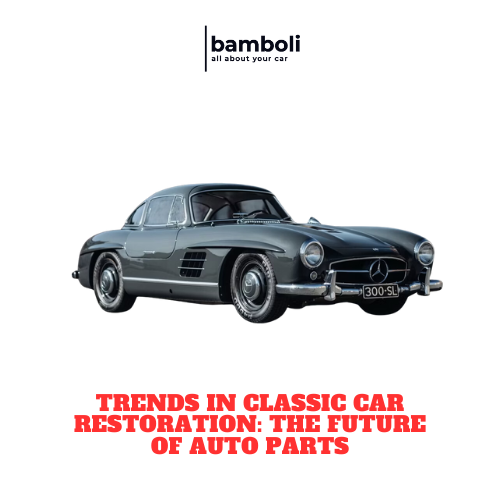Trends in Classic Car Restoration: The Future of Auto Parts

Trends in Classic Car Restoration: The Future of Auto Parts
Classic car restoration is a timeless hobby that continues to capture the hearts of automotive enthusiasts around the world. As technology advances, the future of auto parts in this field is becoming more exciting and innovative. From vintage engines to intricate body panels, the availability of high-quality auto parts plays a crucial role in the successful restoration of classic vehicles. In this blog article, we will explore the latest trends in classic car restoration and how auto parts manufacturers are adapting to meet the needs of this ever-evolving industry.
Innovative Materials for Classic Car Restoration
Restoring a classic car is a labor of love for many enthusiasts. Preserving the beauty and charm of a vintage vehicle requires attention to detail and the use of high-quality materials. In recent years, there have been advancements in materials that offer improved durability, longevity, and aesthetics for classic car restoration projects.
Here are some innovative materials that are revolutionizing the world of classic car restoration:
- Carbon Fiber: This lightweight and strong material is increasingly being used in classic car restoration to replace traditional metal parts. Carbon fiber not only reduces the overall weight of the vehicle but also enhances its performance.
- Aluminum Alloys: Aluminum alloys are corrosion-resistant and can be easily molded into intricate designs. They are a popular choice for classic car restoration due to their durability and versatility.
- 3D-Printed Parts: With advancements in technology, 3D printing has become a game-changer for classic car restoration. Custom parts can now be printed with precision, allowing for a perfect fit and finish.
These innovative materials are transforming the way classic cars are restored, offering enthusiasts new possibilities for preserving and enhancing the charm of vintage vehicles. Incorporating these materials into restoration projects can elevate the overall quality and longevity of classic cars for generations to come.
Advanced Technologies Reshaping Auto Parts Manufacturing
In recent years, the automotive industry has witnessed a significant transformation in the way auto parts are manufactured. Advanced technologies such as artificial intelligence, robotics, and 3D printing have revolutionized the production process, making it more efficient and cost-effective.
One of the key technologies that is reshaping auto parts manufacturing is artificial intelligence. AI-powered systems are being used to optimize production processes, enhance quality control, and improve supply chain management. By analyzing large amounts of data in real-time, AI can identify patterns and trends that human operators may overlook, leading to more accurate decision-making and better overall performance.
Robotics is another technology that is playing a crucial role in the manufacturing of auto parts. Robots are being used for tasks that are repetitive, dangerous, or require precision, such as welding, painting, and assembly. By automating these processes, manufacturers can increase productivity, reduce errors, and improve worker safety.
3D printing
|
Benefits of 3D Printing in Auto Parts Manufacturing |
Challenges of Implementing 3D Printing |
|
- Rapid prototyping |
- Material limitations |
3D printing, also known as additive manufacturing, is revolutionizing the way auto parts are designed and produced. This technology allows manufacturers to create complex geometries and intricate components that would be difficult or impossible to produce using traditional manufacturing methods. By eliminating the need for tooling and reducing waste, 3D printing can significantly reduce production costs and lead times.
In conclusion, advanced technologies such as artificial intelligence, robotics, and 3D printing are reshaping the auto parts manufacturing industry. By embracing these innovations, manufacturers can stay competitive, improve efficiency, and deliver high-quality products to consumers.
Sustainable Practices in Classic Car Restoration
Restoring classic cars can be a rewarding hobby for many enthusiasts, but it is important to consider sustainable practices in the process. Preserving, recycling, and reusing materials are key elements to ensure that classic car restoration is done in an environmentally friendly way.
Preserving Original Parts
One of the most important sustainable practices in classic car restoration is preserving original parts. Instead of replacing every part with new ones, enthusiasts can save and restore the original components of the car. This not only helps in maintaining the historical authenticity of the vehicle but also reduces the demand for new parts production.
Recycling and Reusing Materials
Another sustainable practice is recycling and reusing materials whenever possible. Old car parts can be refurbished and used again, reducing the amount of waste generated during the restoration process. Additionally, using eco-friendly products and materials can further minimize the environmental impact of classic car restoration.
By incorporating these sustainable practices into classic car restoration, enthusiasts can not only enjoy their hobby but also contribute to the preservation of the environment for future generations.
Digital Tools Revolutionizing the Restoration Process
In recent years, the restoration industry has seen a significant transformation with the advent of various digital tools. These tools have revolutionized the way restoration professionals work, making the process more efficient and effective.
- 3D Imaging Technology
One of the most impactful digital tools in the restoration process is 3D imaging technology. This technology allows restoration professionals to create detailed and accurate 3D models of damaged structures quickly and accurately. These models help in assessing the extent of the damage, planning the restoration process, and communicating effectively with clients and other stakeholders.
- Drones
Drones have also become indispensable tools in the restoration industry. These unmanned aerial vehicles can access hard-to-reach areas and capture high-resolution images and videos of the damaged structures. This innovative technology helps in conducting inspections, monitoring progress, and ensuring safety during the restoration process.
- Building Information Modeling (BIM)
Building Information Modeling, or BIM, is a digital tool that enables restoration professionals to create detailed 3D models of buildings and infrastructure. These models not only help in identifying existing issues but also in simulating different restoration scenarios. BIM facilitates collaboration among different teams, streamlines communication, and minimizes errors during the restoration process.
The Impact of Digital Tools
The integration of digital tools in the restoration process has revolutionized the industry, making it more efficient, cost-effective, and sustainable. By leveraging these tools, restoration professionals can deliver high-quality results in a timely manner, exceeding client expectations and ensuring the longevity of restored structures.
Customization Trends in Classic Car Parts
Classic cars hold a special place in the hearts of many enthusiasts. From vintage engines to iconic designs, these vehicles are a symbol of a bygone era. One of the most popular ways to enhance the beauty and performance of classic cars is through customization.
The first trend in classic car customization is restoration.
Restoration involves bringing a classic car back to its original glory. This process often includes repairing and replacing old parts, repainting the exterior, and polishing the interior. Many enthusiasts believe that restoring a classic car is the best way to preserve its history and value.
Custom paint jobs are another popular trend in classic car customization.
From metallic finishes to bold colors, custom paint jobs can completely transform the look of a classic car. Many owners choose to add unique graphics or patterns to make their vehicle stand out from the crowd. Custom paint jobs are a great way to showcase individual style and creativity.
Performance upgrades are essential for classic car enthusiasts who want to improve the speed and handling of their vehicle.
Upgrading the engine, suspension, and brakes can greatly enhance the performance of a classic car. Many owners also opt for modern amenities such as air conditioning, power steering, and navigation systems to make their ride more comfortable and enjoyable. Performance upgrades not only improve the driving experience but also increase the overall value of the vehicle.
Overall, customization trends in classic car parts continue to evolve as enthusiasts seek new ways to enhance the beauty and performance of their beloved vehicles. Whether it's through restoration, custom paint jobs, or performance upgrades, there are endless possibilities to make a classic car truly one-of-a-kind.
Challenges and Solutions in Finding Rare Auto Parts
Finding rare auto parts can be a daunting task for car enthusiasts and collectors. Whether you are restoring a vintage vehicle or looking to make modifications to your current ride, sourcing rare parts can present a number of challenges. However, with some patience and strategic planning, you can overcome these obstacles and find the parts you need to complete your project.
Challenges:
One of the main challenges in finding rare auto parts is the limited availability. Some parts may be out of production or simply hard to come by due to their rarity. This can make it difficult to locate a specific part that matches the make and model of your vehicle.
Another challenge is the high cost associated with rare auto parts. Since these parts are in high demand and low supply, sellers can command a premium price for them. This may not be feasible for budget-conscious individuals or those working on a tight financial plan.
Lastly, the issue of authenticity can also pose a challenge when sourcing rare auto parts. With the rise of counterfeit products in the market, it can be difficult to verify the authenticity of a part and ensure that it meets the required standards for your vehicle.
"Finding rare auto parts is like searching for a needle in a haystack. It requires patience, dedication, and a keen eye for detail."
Solutions:
Despite these challenges, there are several solutions that can help you in your search for rare auto parts. One option is to expand your network within the car community. By connecting with other enthusiasts and collectors, you may be able to tap into their resources and discover hidden gems.
Another solution is to explore online marketplaces and forums dedicated to auto parts. Websites such as eBay, Craigslist, and specialty car forums can be valuable resources for finding rare parts. Additionally, reaching out to specialized auto shops and dealerships may also lead you to the parts you need.
Lastly, consider working with reputable sellers and retailers who specialize in rare auto parts. By doing your research and verifying the authenticity of the parts, you can ensure that you are getting high-quality products that are worth the investment.
|
Challenge |
Solution |
|
Limited Availability |
Expand your network and explore online marketplaces |
|
High Cost |
Research reputable sellers and dealerships |
|
Authenticity |
Verify the authenticity of the parts before purchasing |
Future Market Trends for Classic Car Restoration
Classic car restoration is a timeless hobby that has been gaining popularity over the years. As technology advances, the market trends for classic car restoration are also evolving. Here are some future market trends to keep an eye on:
- Electric Vehicle Conversions
The future of classic car restoration may involve converting traditional gasoline-powered vehicles into electric cars. This trend is gaining momentum as more people are becoming environmentally conscious and looking for sustainable alternatives.
- 3D Printing for Parts
With the advancement of 3D printing technology, classic car enthusiasts may have easier access to rare or hard-to-find parts. Custom parts can be manufactured on demand, making restoration projects more feasible and cost-effective.
- Online Marketplaces for Restoration Services
Online platforms specializing in classic car restoration services are likely to become more popular. Enthusiasts can connect with experts, buy/sell parts, and even showcase their projects to a wider audience. This trend opens up new opportunities for collaboration and learning within the community.
- Increased Demand for Luxury Classics
As the global economy continues to grow, the demand for luxury classic cars is expected to rise. Concours-quality restorations of high-end vehicles will be in high demand among collectors and enthusiasts alike.
- Integration of AI and AR Technologies
Artificial intelligence and augmented reality technologies may revolutionize the way classic cars are restored and showcased. AI can assist in identifying parts, while AR can provide immersive experiences for enthusiasts to visualize their restoration projects before completion.
- Sustainable Restoration Practices
With a growing focus on sustainability, classic car restoration trends may shift towards using eco-friendly materials and practices. Restorers may opt for renewable resources and energy-efficient solutions to preserve the environment while pursuing their passion.
- Electric Vehicle Conversions: This trend addresses the shift towards sustainable transportation options.
- 3D Printing for Parts: Custom-made parts offer flexibility and efficiency in restoration projects.
- Online Marketplaces for Restoration Services: Connecting enthusiasts and professionals for a collaborative restoration experience.
- Increased Demand for Luxury Classics: Catering to the growing preference for high-end classic cars among collectors.
- Integration of AI and AR Technologies: Enhancing the restoration process with advanced technological solutions.
- Sustainable Restoration Practices: Promoting eco-friendly approaches in classic car restoration.
Frequently Asked Questions
What is the main topic of the article?
The main topic of the article is...
Why is this topic important?
This topic is important because...
Who can benefit from the information provided in the article?
Individuals interested in... can benefit from the information.
Are there any additional resources recommended for further reading?
Yes, additional reading materials include...
How can one implement the suggestions given in the article?
To implement the suggestions, one can start by...




